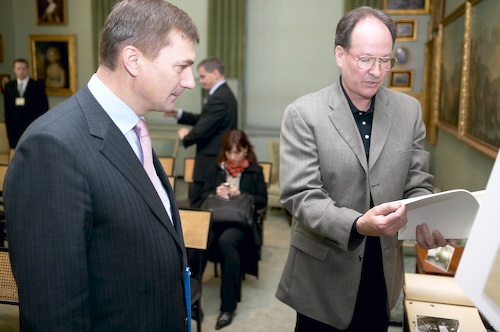Visit of Estonian Prime Minister to the Hoover Institution Library and Archives
On November 30, 2007, Estonian Prime Minister Andrus Ansip visited Stanford University, where he gave a speech on the Estonian economy to an audience at the Hoover Institution on War, Revolution, and Peace. During his time at Stanford, the prime minister was given a presentation on Estonian history as reflected in the collections of the Hoover Institution Library and Archives.
Materials relating to the first years of Estonian independence form part of the founding collections of the Hoover library and archives. Herbert Hoover attended the Versailles Peace Conference and collected numerous documents from the various delegations to the conference, including the Estonian one. He was also in charge of the American Relief Administration, a massive undertaking that delivered food and supplies to Europe and Russia after World War I, and which fed large numbers of Estonian children as part of this effort. Documents from the Versailles Peace Conference and the records of the American Relief Administration were sent by Herbert Hoover to his alma mater, Stanford University, where they became part of the initial holdings of the library and archives.
The prime minister’s delegation was shown a 1920 map of Estonia prepared for the Versailles Peace Conference. The map shows Estonia’s borders as negotiated on the basis of the Peace of Tartu; it also shows the extent of the ethnic Estonian population at the time, an area considerably larger than the borders of the newly-independent Estonian state as established in 1918. A hand-drawn map showing the feeding stations in Estonia of the American Relief Administration was also on display. On the undated map, it was noted that 43,000 Estonian were being fed on a daily basis by the A.R.A.
The delegation was shown a series of photographs depicting the commemoration in Tallinn of the 10th anniversary of Estonian independence. These 1928 photographs are part of the Franciszek Charwat Collection in the archives and along with various Estonian dignitaries, the photographs show scenes of a military parade and a song festival, as well as some views of Tallinn. Charwat was a Polish diplomat posted to the Baltic states in the 1920s.
The archives has other materials relating to the first period of Estonian independence, and Prime Minister Ansip and his party were shown documents from the Kaarel Robert Pusta Papers. These included correspondence from Pusta’s time as Estonian foreign minister, as well as materials following the loss of Estonian independence, when Pusta maintained an Estonian legation in Spain.
Of special interest to the Estonian visitors was a rare album of photographs belonging to the archives that depicts the signing of the Molotov-Ribbentrop pact in Moscow in 1939. The album, which includes photographs of a smiling Stalin conversing with Nazi officials, was created by the German foreign ministry, and was found by an American soldier at the end of World War II.
The experience of Estonian refugees following World War II is also documented in the archives. The delegation was shown a yearbook and a map from the Estonian Displaced Persons camp in Geislingen, Germany. This elicited an emotional response from a member of the audience (a local resident who is a relative of the prime minister) who had spent her early childhood in the camp. When looking at the map of the camp, she was able to point out exactly where her family had lived and where she had gone to school.
Another reaction from those attending the presentation came during the discussion of the large Radio Free Europe/Radio Liberty collection in the archives, a collection that includes recordings of broadcasts of Radio Free Europe’s Estonian service. A photograph of Estonian President Toomas Hendrik Ilves, dating from when he worked for Radio Free Europe and wore a beard, had his son — a student at Stanford who attended the presentation — puzzled at first, as he did not immediately recognize the person in the picture. After a closer inspection of the photograph, he agreed that it was indeed his father.
A number of items from the large poster collection in the archives were also on display. These included one showing the commemoration in Tallinn of the 45th anniversary of the bombing of the city in 1944. Also on display was a poster from Lithuania depicting the Baltic Way, a human chain marking the 50th anniversary of the Molotov-Ribbentrop pact.
The prime minister’s delegation was also told of the ongoing collecting activities of the library and archives in relation to Estonia. Some campaign materials from the recent elections in Estonia were shown as part of the presentation. Special mention was also made to Prime Minster Ansip of the International Conference on the Baltic Archives Abroad held in Tartu in 2006.
David Jacobs
Hoover Institution Archives
